Oracle Bundle
How Does Oracle Dominate the Enterprise Software Market?
Oracle, a titan in the tech world, has continually adapted its sales and marketing strategies to stay ahead of the curve. From its humble beginnings in database software to its current cloud-centric focus, Oracle's evolution is a masterclass in strategic adaptation. This deep dive explores the intricacies of Oracle's approach, revealing the secrets behind its enduring success.
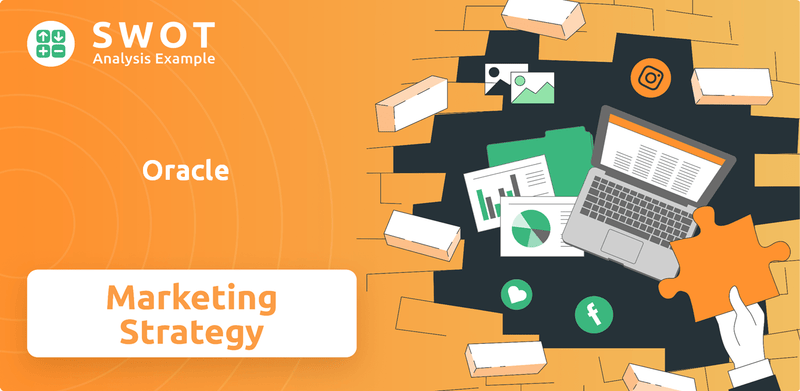
This exploration of Oracle's Oracle SWOT Analysis will uncover the core elements of its Oracle sales strategy and Oracle marketing strategy. We'll analyze how Oracle navigates the competitive landscape, examining its Oracle business strategy, Oracle products, and Oracle market share against its Oracle competitors. Understanding Oracle's Oracle sales and marketing approach provides invaluable insights for any business strategist.
How Does Oracle Reach Its Customers?
The sales channels of Oracle are designed to reach a diverse customer base, including large enterprises, small and medium enterprises (SMEs), and developers. Oracle's approach combines direct sales with a strong partner ecosystem. This multi-faceted strategy allows Oracle to effectively market its products and services across various market segments and geographies.
Historically, Oracle's direct sales force played a dominant role in its go-to-market strategy. However, the shift to cloud computing has necessitated an evolution, with partnerships becoming increasingly critical to Oracle's success. The company has a robust presence in over 100 countries, demonstrating a global reach that supports its sales and marketing efforts.
In fiscal year 2024, Oracle achieved record sales contracts, driven by substantial demand for training AI large language models (LLMs) in Oracle Cloud. This success contributed to a 44% increase in remaining performance obligations (RPO) to $98 billion, highlighting the effectiveness of its evolving sales strategy, particularly in securing large, multi-year cloud contracts. This demonstrates the effectiveness of its evolving sales strategy, particularly in securing large, multi-year cloud contracts.
Oracle's direct sales teams are crucial for engaging with large enterprises and key accounts. These teams focus on building relationships and providing tailored solutions. They are responsible for closing major deals and ensuring customer satisfaction.
Oracle has a vast partner network that includes system integrators, value-added resellers, and cloud service providers. This network expands Oracle's reach and provides specialized expertise. Partners help in implementing and supporting Oracle products.
Oracle utilizes its digital platforms for marketing, sales, and customer engagement. These platforms include its website, social media channels, and online marketplaces. They facilitate lead generation and provide resources for customers.
A key strategic shift for Oracle has been its focus on expanding partnerships with other technology giants. Oracle has forged groundbreaking partnerships with Microsoft Azure and Google Cloud. This multi-cloud approach enhances Oracle's market position, broadens its reach, and offers customers greater flexibility and interoperability.
Oracle's partnerships with Microsoft Azure and Google Cloud are pivotal in its sales strategy. These collaborations allow customers to run Oracle databases as native services within these hyperscale environments. This approach broadens Oracle's market reach and provides customers with greater flexibility.
- These partnerships are expected to enhance Oracle's market position and attract a broader customer base.
- The integration of Oracle database services with Google Cloud was set to go live in September 2024.
- Oracle's ability to adapt its sales channels and embrace strategic partnerships is crucial for its continued success in the cloud computing market.
- The company's go-to-market strategy is also influenced by its historical context, as explored in Brief History of Oracle.
Oracle SWOT Analysis
- Complete SWOT Breakdown
- Fully Customizable
- Editable in Excel & Word
- Professional Formatting
- Investor-Ready Format
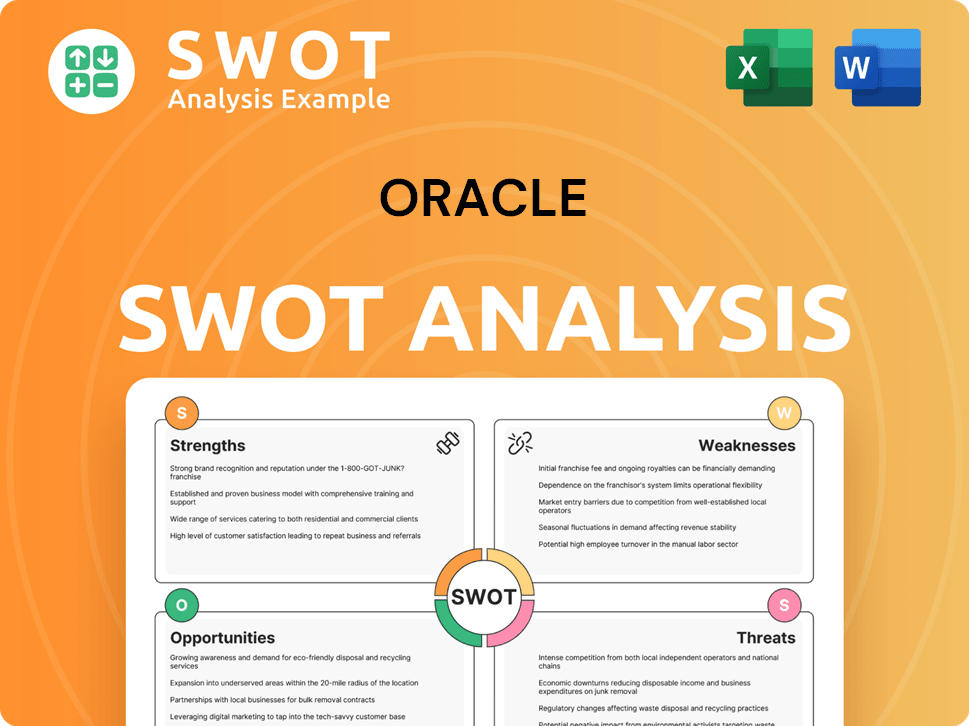
What Marketing Tactics Does Oracle Use?
The marketing tactics of Oracle are designed to build brand awareness, generate leads, and drive sales through a multi-channel approach. This strategy integrates both traditional and digital marketing channels, focusing on data-driven campaigns and customer engagement. Oracle's approach emphasizes real-time personalization and sophisticated customer engagement techniques.
In 2024 and 2025, Oracle's marketing strategy continues to evolve, emphasizing data-driven insights and predictive analytics to optimize marketing efforts. The company leverages its own products, such as the Autonomous Database, to showcase the capabilities of its offerings and ensure efficient marketing operations. This approach allows Oracle to create tailored campaigns that resonate with specific audience segments, leading to improved customer acquisition and retention.
A key element of Oracle's marketing strategy is its focus on the customer journey. By mapping the customer experience, Oracle aims to provide relevant and timely information, converting leads into customers. This strategy is supported by marketing automation tools and innovative content marketing, ensuring a cohesive and engaging experience across all touchpoints.
Oracle's digital marketing strategy includes content marketing, SEO, paid advertising, email marketing, and social media. The company uses thought leadership articles, webinars, and whitepapers to establish brand authority and highlight industry insights. This approach drives traffic and generates leads.
Oracle engages its audience through thought leadership articles, webinars, and whitepapers. These content pieces provide valuable insights and establish the company as an industry expert. This strategy helps to attract and retain customers.
Oracle utilizes data-driven insights and predictive analytics to optimize marketing efforts. This approach helps to anticipate customer behaviors and improve marketing ROI. The company focuses on real-time personalization to create tailored campaigns.
Oracle uses its Oracle Unity Customer Data Platform to transform customer data silos into actionable profiles. This enables improved customer acquisition and retention. The platform helps to create a unified view of the customer.
Oracle participates in major industry events and sponsorships. Events like Oracle CloudWorld serve as key platforms for showcasing innovations in AI integration and multi-cloud capabilities. This approach helps to engage with customers and partners.
Oracle's marketing mix for 2025 focuses on the 7Ps: Product, Price, Place, Promotion, People, Physical Evidence, and Process. Integrating these elements ensures cohesive customer engagement. This comprehensive approach supports the overall business strategy.
Oracle's marketing strategy is heavily influenced by its product offerings and market position. The company's sales and marketing approach is designed to highlight the benefits of its products, such as cloud solutions, and address the needs of its target audience. For more insights into the financial aspects of Oracle, including ownership and shareholder information, you can read more at Owners & Shareholders of Oracle.
Oracle employs various marketing tactics to reach its target audience and drive sales. These tactics include digital marketing, content marketing, and participation in industry events. The company's focus on data-driven insights and customer engagement is central to its strategy.
- Content Marketing: Oracle uses thought leadership articles, webinars, and whitepapers.
- Digital Marketing: SEO, paid advertising, email marketing, and social media are key channels.
- Industry Events: Participation in major events like Oracle CloudWorld.
- Data-Driven Approach: Leveraging data and predictive analytics to optimize marketing efforts.
- Customer Data Platform: Utilizing Oracle Unity for improved customer acquisition and retention.
Oracle PESTLE Analysis
- Covers All 6 PESTLE Categories
- No Research Needed – Save Hours of Work
- Built by Experts, Trusted by Consultants
- Instant Download, Ready to Use
- 100% Editable, Fully Customizable
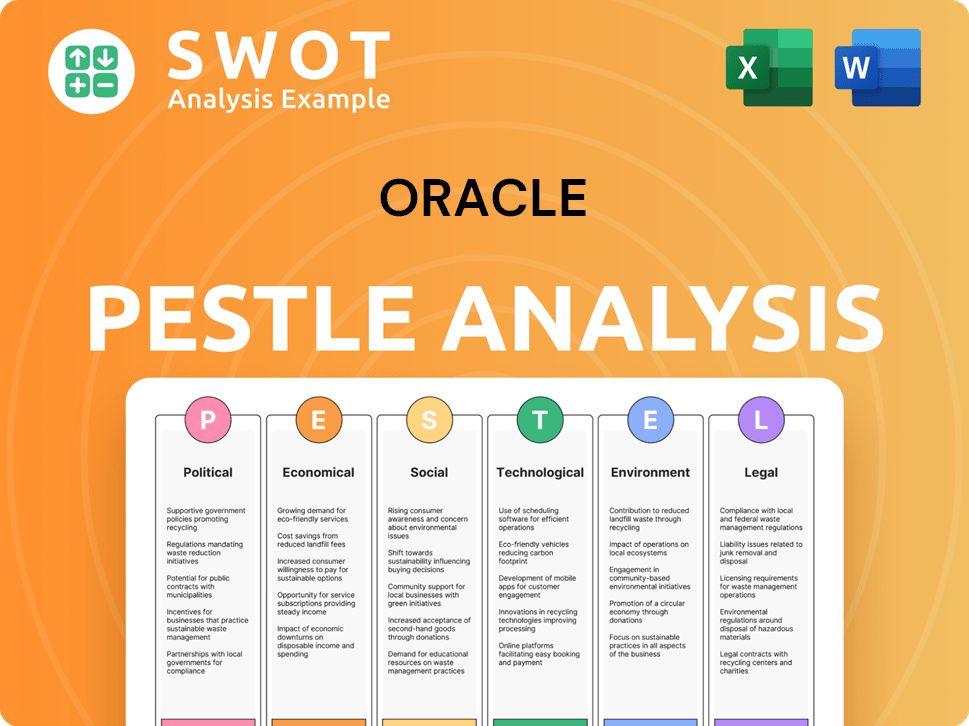
How Is Oracle Positioned in the Market?
The brand positioning of Oracle centers around innovation, reliability, and deep expertise in software and hardware. It's strategically positioned as a comprehensive provider of integrated cloud applications and platform services, targeting large corporations and government entities. This 'one-stop shop' approach is crucial for its enterprise-scale customer base.
Oracle differentiates itself through a commitment to innovation and customer success. It offers end-to-end solutions that seamlessly integrate with legacy systems, a critical requirement for its enterprise-scale customer base. The company's core message emphasizes delivering enterprise-grade solutions that are smarter, more secure, and more sustainable.
The company's visual identity, particularly the Oracle logo, is simple, bold, and consistent across various media, symbolizing trust and reliability. The assertive red color symbolizes energy, power, and passion, reflecting Oracle's expanded offerings in hardware and cloud services. The tone of voice is professional, stable, and reliable, aiming to build trust with its B2B audience.
Oracle invests significantly in embedding AI into its ERP, CRM, and SCM applications. This focus on innovation is a key element of its Oracle marketing strategy. The company's unique selling propositions include a strong commitment to customer success and its network of customer engagement platforms.
Oracle integrates advanced data analytics and AI to adapt marketing campaigns based on customer feedback. This approach is crucial for understanding Oracle's target audience and tailoring its messaging effectively. Brand consistency is maintained across all touchpoints.
Oracle has shown adaptability in response to shifts in the industry. As cloud computing reshaped the industry, Oracle strategically shifted its focus and marketing messages to highlight its cloud solutions. This is a key element of its Oracle sales and marketing approach.
The company's multi-cloud strategy, including partnerships with Microsoft and Google, enhances its market positioning. This approach directly addresses competitive pressures from other hyperscale cloud providers. This is a crucial part of Oracle's go-to-market strategy.
Oracle's brand consistency is maintained across all touchpoints, from its website and social media channels to digital ads and email campaigns, ensuring a unified and recognizable identity. This consistency helps reinforce customer trust and loyalty. To understand the competitive landscape in which Oracle operates, consider reading about the Competitors Landscape of Oracle.
Oracle Business Model Canvas
- Complete 9-Block Business Model Canvas
- Effortlessly Communicate Your Business Strategy
- Investor-Ready BMC Format
- 100% Editable and Customizable
- Clear and Structured Layout
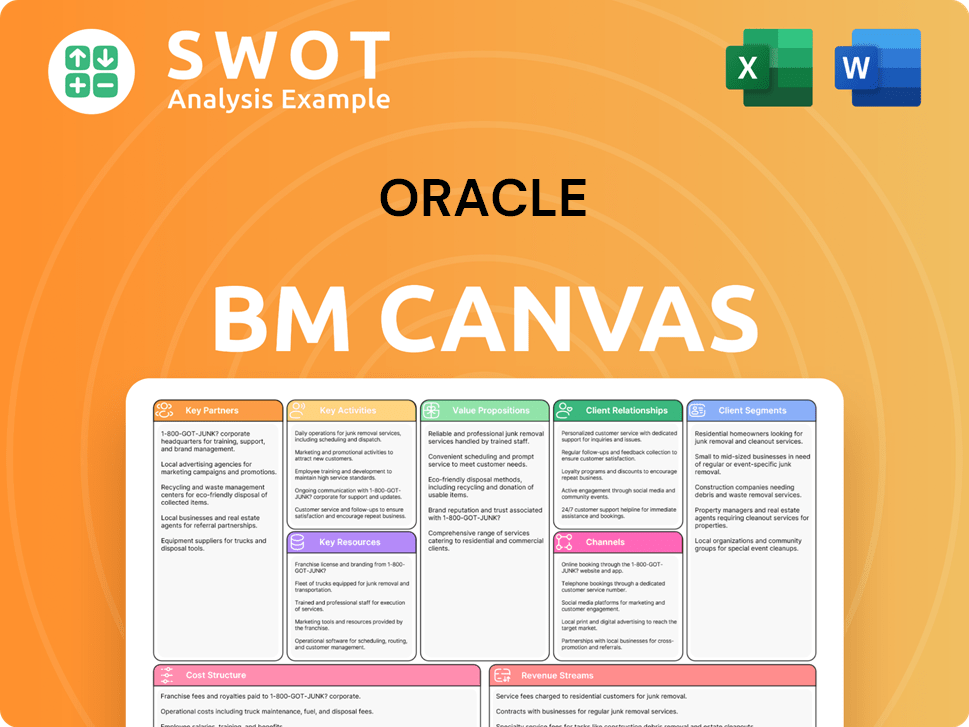
What Are Oracle’s Most Notable Campaigns?
The sales and marketing campaigns of Oracle are heavily influenced by its product evolution and strategic shifts, particularly its focus on cloud and AI. While specific campaign names are not as prominently publicized as those of consumer brands, their impact is clear in the company's financial results and market positioning. These campaigns are designed to drive significant revenue growth and establish Oracle as a leader in the tech industry.
One of the main ongoing initiatives is Oracle's expansion into cloud infrastructure (OCI) and AI services. This strategic push has resulted in substantial sales contracts. The company is focused on securing large, multi-year cloud contracts and positioning itself as a key player in the AI and cloud space. Oracle's approach includes direct sales, strategic partnerships, and industry events.
Oracle's marketing strategy also emphasizes integrated marketing communications. This involves harmonizing messages across various platforms, including digital and traditional media, and using omnichannel loyalty programs. The aim is to ensure consistent brand messaging and foster deeper customer relationships, especially as the company prioritizes customer-centric initiatives and personalized experiences.
This ongoing campaign aggressively promotes Oracle's cloud infrastructure (OCI) and AI services. This has led to record-breaking sales contracts, with over 30 AI sales contracts signed in Q4 fiscal year 2024. The goal is to secure large, multi-year cloud deals and establish Oracle as a leader in AI and cloud.
Oracle CloudWorld is a major platform for showcasing innovations and engaging with customers and partners. The CloudWorld 2024 event, for example, highlighted AI integration and multi-cloud capabilities. These events are crucial for driving engagement and demonstrating Oracle's commitment to cloud adoption and advanced digital strategies.
Oracle uses integrated marketing communications to harmonize messages across various platforms. With a sales and marketing budget of approximately $1.771 billion in 2025, the company focuses on consistent brand messaging and deeper customer relationships. This approach aims to strengthen customer engagement and build loyalty.
Oracle leverages data-driven insights and its own technologies to enhance marketing effectiveness. Although its advertising division saw revenues decline to around $300 million in 2024, the company continues to adapt its strategies based on evolving digital advertising dynamics and data privacy regulations.
Oracle's strategies involve a multi-faceted approach to sales and marketing. The company focuses on securing large cloud contracts and enhancing customer engagement through integrated marketing. These strategies are vital for maintaining and growing its market share.
- Cloud and AI Focus: Aggressively promoting cloud infrastructure (OCI) and AI services.
- Strategic Partnerships: Collaborating with major tech firms like Microsoft and Google.
- Industry Events: Utilizing events like Oracle CloudWorld to showcase innovations.
- Integrated Communications: Harmonizing messages across digital and traditional media.
- Data-Driven Insights: Leveraging its own technologies to enhance marketing effectiveness.
Oracle Porter's Five Forces Analysis
- Covers All 5 Competitive Forces in Detail
- Structured for Consultants, Students, and Founders
- 100% Editable in Microsoft Word & Excel
- Instant Digital Download – Use Immediately
- Compatible with Mac & PC – Fully Unlocked
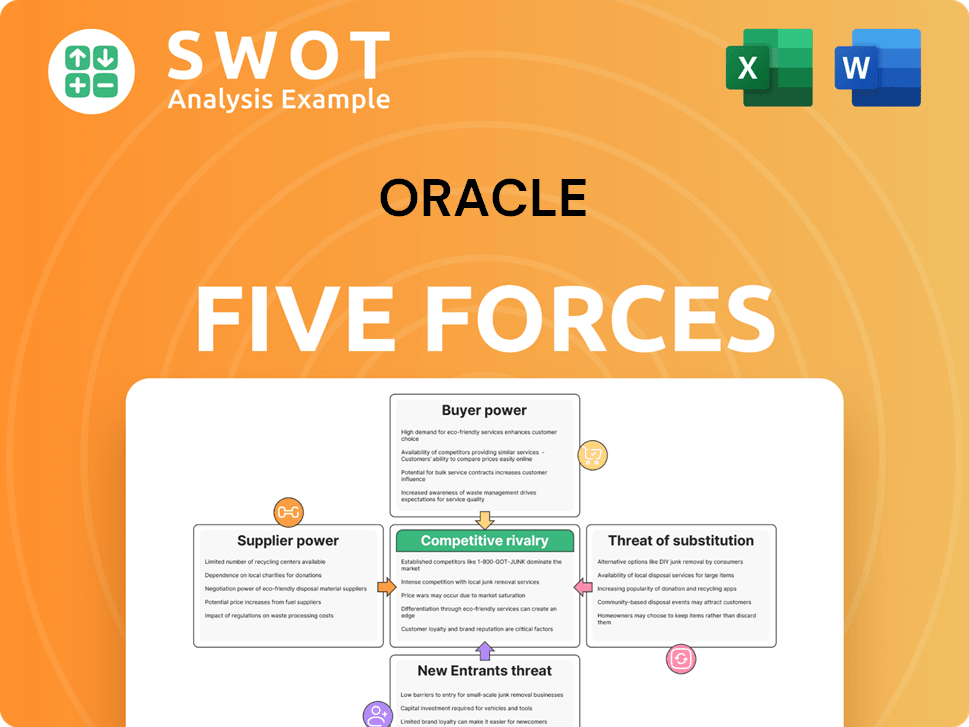
Related Blogs
- What are Mission Vision & Core Values of Oracle Company?
- What is Competitive Landscape of Oracle Company?
- What is Growth Strategy and Future Prospects of Oracle Company?
- How Does Oracle Company Work?
- What is Brief History of Oracle Company?
- Who Owns Oracle Company?
- What is Customer Demographics and Target Market of Oracle Company?
Disclaimer
All information, articles, and product details provided on this website are for general informational and educational purposes only. We do not claim any ownership over, nor do we intend to infringe upon, any trademarks, copyrights, logos, brand names, or other intellectual property mentioned or depicted on this site. Such intellectual property remains the property of its respective owners, and any references here are made solely for identification or informational purposes, without implying any affiliation, endorsement, or partnership.
We make no representations or warranties, express or implied, regarding the accuracy, completeness, or suitability of any content or products presented. Nothing on this website should be construed as legal, tax, investment, financial, medical, or other professional advice. In addition, no part of this site—including articles or product references—constitutes a solicitation, recommendation, endorsement, advertisement, or offer to buy or sell any securities, franchises, or other financial instruments, particularly in jurisdictions where such activity would be unlawful.
All content is of a general nature and may not address the specific circumstances of any individual or entity. It is not a substitute for professional advice or services. Any actions you take based on the information provided here are strictly at your own risk. You accept full responsibility for any decisions or outcomes arising from your use of this website and agree to release us from any liability in connection with your use of, or reliance upon, the content or products found herein.